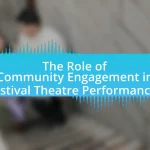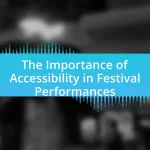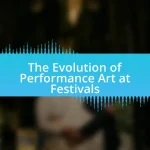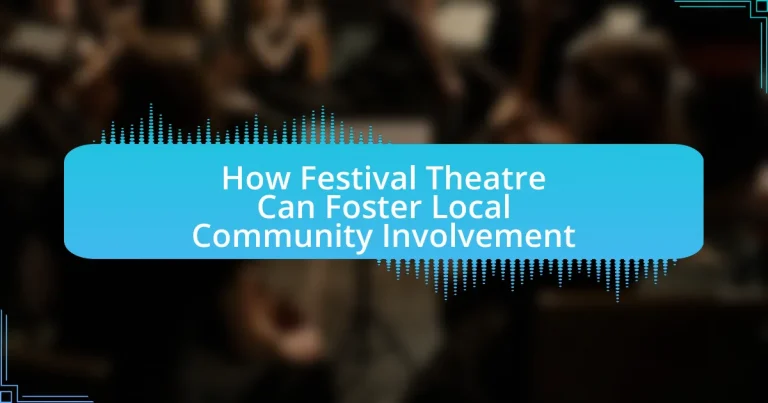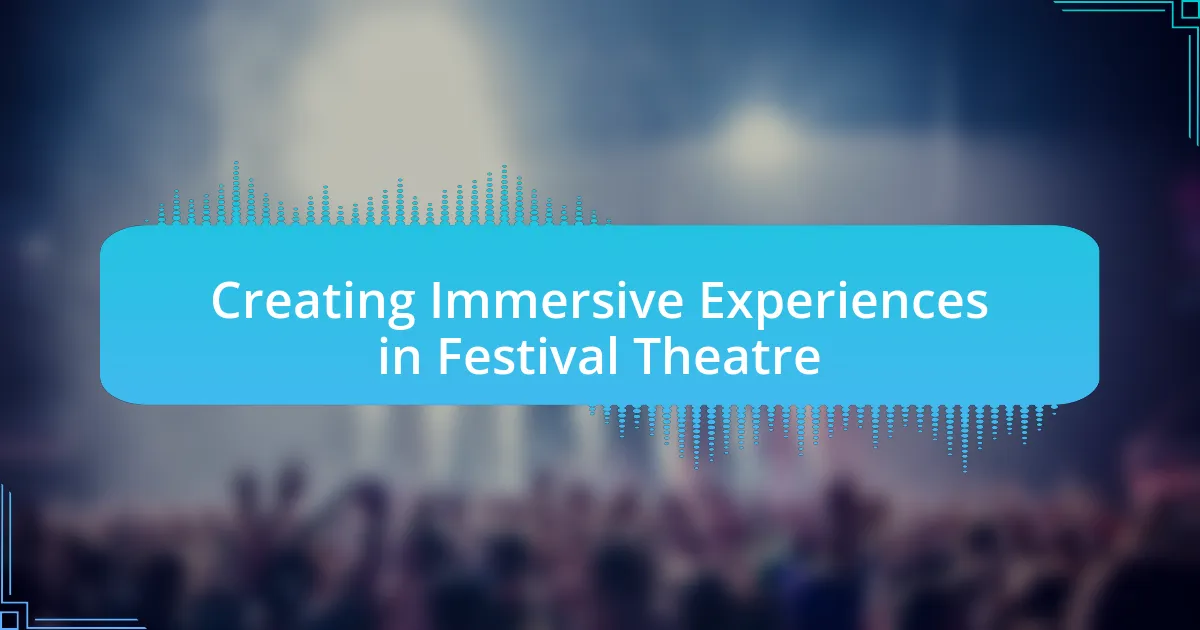Festival theatre serves as a vital platform for engaging local communities by showcasing local artists and fostering a sense of ownership and pride. It enhances community building through social cohesion and cultural exchange, while promoting social interaction among residents. The article explores how community involvement in festival theatre not only enriches the festival experience but also contributes to local economic growth and sustainability. Key elements for successful engagement include collaboration, inclusivity, and active participation, which are essential for attracting diverse community members and ensuring relevant programming. Additionally, the article addresses challenges faced by festival theatres and offers strategies to overcome them, highlighting the significant benefits of community involvement in enhancing social ties and providing educational opportunities for local youth.

How can festival theatre engage local communities?
Festival theatre can engage local communities by providing a platform for local artists and performers to showcase their talents, thereby fostering a sense of ownership and pride within the community. This engagement is further enhanced through collaborative workshops and outreach programs that invite community members to participate in the creative process, allowing them to contribute to the festival’s programming. For instance, studies have shown that festivals that incorporate local narratives and cultural elements not only attract larger audiences but also strengthen community bonds, as evidenced by the success of events like the Edinburgh Festival Fringe, which features numerous local acts and engages residents in various capacities.
What role does festival theatre play in community building?
Festival theatre plays a crucial role in community building by fostering social cohesion and cultural exchange among residents. It serves as a platform for local artists and performers to showcase their talents, thereby enhancing community pride and identity. Research indicates that participation in community arts, including festival theatre, can lead to increased social interaction and collaboration among diverse groups, which strengthens community ties. For instance, a study by the National Endowment for the Arts found that communities with active arts programs report higher levels of civic engagement and volunteerism, demonstrating the positive impact of festival theatre on community involvement.
How does festival theatre promote social interaction among residents?
Festival theatre promotes social interaction among residents by creating a communal space where individuals can gather, share experiences, and engage in cultural activities. This environment fosters connections through collaborative performances, workshops, and discussions that encourage participation from diverse community members. Research indicates that events like festival theatre enhance social cohesion by providing opportunities for residents to meet, collaborate, and build relationships, ultimately strengthening community ties. For example, a study by the National Endowment for the Arts found that participation in arts events, including theatre festivals, significantly increases social engagement and community involvement among attendees.
What opportunities does festival theatre create for local artists?
Festival theatre creates opportunities for local artists by providing a platform for performance, collaboration, and exposure. Local artists can showcase their work to diverse audiences, enhancing their visibility and credibility within the arts community. Additionally, festival theatre often includes workshops and mentorship programs, allowing local artists to develop their skills and network with established professionals. Research indicates that festivals can significantly boost local economies and cultural engagement, as seen in studies like “The Economic Impact of Festivals” by the National Endowment for the Arts, which highlights how such events stimulate local artistic ecosystems.
Why is community involvement important in festival theatre?
Community involvement is important in festival theatre because it enhances cultural expression and strengthens social bonds within the community. Engaging local residents in the planning and execution of festival theatre fosters a sense of ownership and pride, which can lead to increased attendance and support for the arts. Studies have shown that communities with active participation in cultural events experience greater social cohesion and improved mental well-being, as evidenced by research from the Arts Council England, which highlights the positive impact of community arts on local engagement and identity.
How does community participation enhance the festival experience?
Community participation enhances the festival experience by fostering a sense of belonging and ownership among attendees. When local residents actively engage in planning and executing festival activities, it creates a deeper emotional connection to the event, leading to increased attendance and enthusiasm. Research indicates that festivals with high community involvement report greater satisfaction levels among participants, as seen in the 2019 study by the University of Florida, which found that 75% of attendees felt more connected to their community when they participated in local festivals. This connection not only enriches the festival atmosphere but also promotes cultural exchange and strengthens community ties.
What impact does local involvement have on festival sustainability?
Local involvement significantly enhances festival sustainability by fostering community ownership and support. When local residents participate in festival planning and execution, they contribute to a sense of pride and responsibility, which leads to increased volunteerism and attendance. Studies show that festivals with strong local engagement often see higher economic benefits, as local businesses thrive from increased foot traffic and patronage. For instance, a report by the National Endowment for the Arts indicates that community-driven festivals can generate up to 30% more revenue compared to those with minimal local input. This economic boost, coupled with a commitment to preserving local culture and environment, solidifies the long-term viability of festivals.
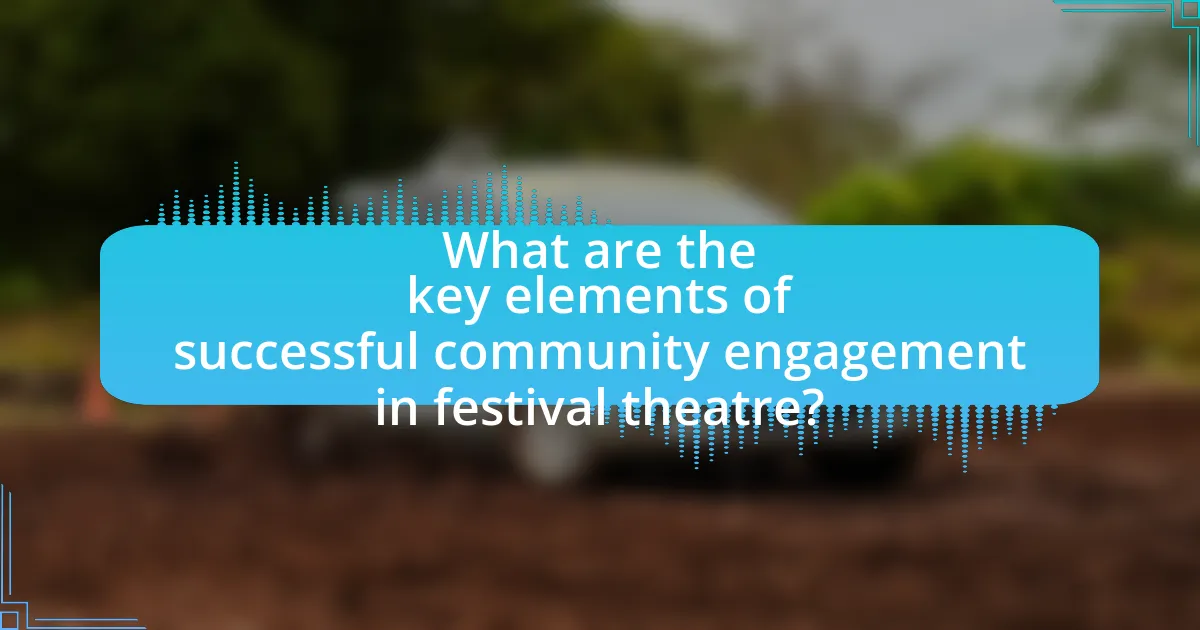
What are the key elements of successful community engagement in festival theatre?
Successful community engagement in festival theatre relies on collaboration, inclusivity, and active participation. Collaboration involves partnerships between festival organizers and local community groups, ensuring that diverse voices are represented in planning and execution. Inclusivity is essential, as it encourages participation from various demographics, fostering a sense of belonging and ownership among community members. Active participation is achieved through workshops, volunteer opportunities, and interactive performances, which empower individuals to contribute creatively and socially. Research indicates that festivals that prioritize these elements see increased attendance and community satisfaction, as evidenced by studies showing that inclusive programming can enhance local pride and cultural identity.
How can festival theatre organizers foster local participation?
Festival theatre organizers can foster local participation by actively engaging community members in the planning and execution of events. This can be achieved through initiatives such as workshops, volunteer opportunities, and partnerships with local schools and organizations, which encourage residents to contribute their skills and creativity. For instance, a study by the National Endowment for the Arts found that community involvement in arts programming increases attendance and enhances the overall experience, demonstrating that local engagement leads to a more vibrant festival atmosphere.
What strategies can be implemented to attract diverse community members?
To attract diverse community members, festival theatres can implement inclusive programming that reflects the cultural backgrounds and interests of various groups. This can include showcasing performances from different cultural traditions, offering multilingual promotional materials, and engaging local artists from diverse backgrounds. Research indicates that events featuring diverse cultural expressions can increase attendance from underrepresented communities, as seen in the 2019 study by the National Endowment for the Arts, which found that inclusive programming significantly boosts participation rates among minority groups. Additionally, establishing partnerships with local organizations that serve diverse populations can enhance outreach efforts and foster a sense of belonging within the community.
How can feedback from the community shape festival programming?
Feedback from the community can significantly shape festival programming by directly influencing the selection of performances, activities, and themes that resonate with local audiences. When organizers actively solicit and incorporate community input, they can tailor the festival experience to reflect the interests and cultural values of the attendees. For instance, a study by the National Endowment for the Arts found that festivals that engage with their communities through surveys and focus groups see increased attendance and satisfaction rates, demonstrating that community feedback leads to more relevant and appealing programming. This alignment not only enhances the festival’s success but also fosters a sense of ownership and pride among community members, further solidifying their involvement and support.
What challenges do festival theatres face in engaging local communities?
Festival theatres face several challenges in engaging local communities, primarily including accessibility, cultural relevance, and financial constraints. Accessibility issues arise when venues are located far from community centers or lack transportation options, making it difficult for local residents to attend events. Cultural relevance is a challenge as festival theatres may struggle to present programming that resonates with the diverse backgrounds and interests of the local population, potentially leading to disengagement. Financial constraints limit the ability of festival theatres to offer affordable ticket prices or free events, which can alienate lower-income community members. These challenges hinder the potential for meaningful community involvement and participation in festival theatre activities.
How can these challenges be overcome to enhance community involvement?
To overcome challenges and enhance community involvement in festival theatre, organizers can implement targeted outreach programs that engage diverse community groups. Research indicates that inclusive programming, such as workshops and collaborative performances, fosters participation by addressing barriers like accessibility and cultural relevance. For instance, a study by the National Endowment for the Arts found that community engagement initiatives significantly increase attendance and participation rates, demonstrating that tailored approaches can effectively draw in local audiences.
What resources are available to support community engagement efforts?
Resources available to support community engagement efforts include grants, training programs, and partnerships with local organizations. Grants from government bodies and foundations provide financial support for community projects, while training programs equip individuals with skills in facilitation and outreach. Additionally, partnerships with local nonprofits and businesses enhance resource sharing and broaden community reach, as evidenced by successful initiatives like the National Endowment for the Arts’ funding programs, which have historically supported community engagement in the arts.
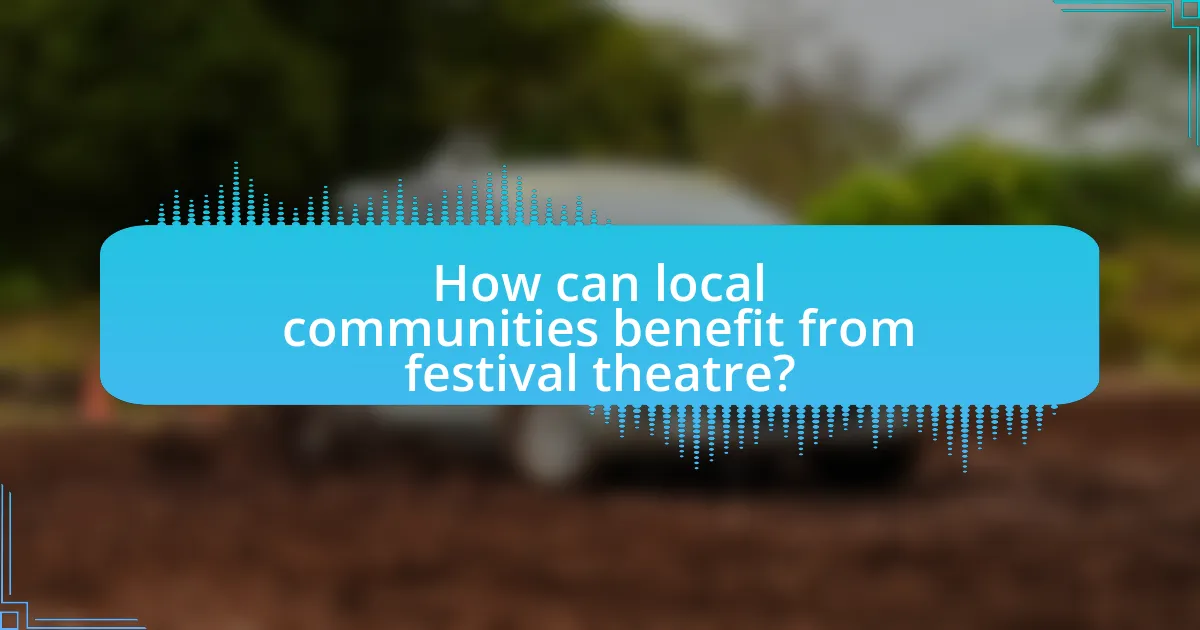
How can local communities benefit from festival theatre?
Local communities can benefit from festival theatre by enhancing social cohesion and stimulating local economies. Festival theatre brings together diverse groups, fostering connections among residents and encouraging collaboration, which strengthens community bonds. Additionally, events like these attract visitors, leading to increased spending in local businesses such as restaurants and hotels. For instance, a study by the National Endowment for the Arts found that arts festivals can generate significant economic impact, with some events reporting up to $1.5 million in local revenue. This dual benefit of social and economic enhancement illustrates how festival theatre serves as a catalyst for community development.
What economic advantages does festival theatre bring to local areas?
Festival theatre brings significant economic advantages to local areas by boosting tourism and generating revenue. Events attract visitors who spend money on accommodations, dining, and local attractions, which stimulates the local economy. For instance, a study by the National Endowment for the Arts found that arts festivals can generate up to $4 in economic activity for every $1 spent on the festival itself. Additionally, festival theatre creates job opportunities in various sectors, including hospitality, retail, and event management, further contributing to local employment rates.
How does festival theatre contribute to local business growth?
Festival theatre contributes to local business growth by attracting visitors who spend money on accommodations, dining, and retail. For instance, a study by the National Endowment for the Arts found that arts events can generate significant economic impact, with attendees spending an average of $31 per person, excluding ticket costs, on local businesses. This influx of visitors during festival periods boosts sales for restaurants, hotels, and shops, thereby stimulating the local economy. Additionally, festival theatre often collaborates with local vendors and artists, further integrating the arts into the community and enhancing business opportunities.
What role does festival theatre play in tourism development?
Festival theatre significantly contributes to tourism development by attracting visitors, enhancing local economies, and promoting cultural exchange. Events such as the Edinburgh Festival Fringe, which draws over 2 million attendees annually, showcase diverse performances that entice tourists, thereby increasing hotel bookings, restaurant patronage, and local business revenues. Additionally, festival theatre fosters a sense of community pride and identity, encouraging local participation and investment in cultural initiatives, which further enriches the tourism experience. This symbiotic relationship between festival theatre and tourism not only boosts economic growth but also cultivates a vibrant cultural landscape that appeals to both visitors and residents.
What social benefits arise from community involvement in festival theatre?
Community involvement in festival theatre fosters social cohesion and enhances community identity. This participation encourages collaboration among diverse groups, leading to stronger interpersonal relationships and a sense of belonging. Research indicates that communities engaged in cultural activities, such as festival theatre, experience increased social capital, which is essential for community resilience and collective problem-solving. For instance, a study by the National Endowment for the Arts found that participation in arts activities can lead to improved community engagement and a greater sense of community pride.
How does participation in festival theatre foster a sense of belonging?
Participation in festival theatre fosters a sense of belonging by creating a shared space for community members to engage in collaborative artistic expression. This collective involvement allows individuals to connect with one another through shared experiences, enhancing social bonds and reinforcing community identity. Research indicates that community-based arts initiatives, such as festival theatre, promote social cohesion by encouraging participation from diverse groups, thereby fostering inclusivity and mutual support. For instance, a study by the National Endowment for the Arts found that participation in community arts activities significantly increases feelings of belonging and connectedness among participants.
What educational opportunities does festival theatre provide for local youth?
Festival theatre provides local youth with various educational opportunities, including workshops, mentorship programs, and performance experiences. These initiatives are designed to enhance skills in acting, stagecraft, and production, fostering creativity and confidence among participants. For instance, many festival theatres collaborate with local schools to offer drama classes and summer camps, allowing students to engage in hands-on learning. Additionally, mentorship from experienced theatre professionals helps youth gain insights into the industry, promoting career exploration in the arts. Such programs not only develop artistic talents but also encourage teamwork and communication skills, contributing to the overall growth of young individuals in the community.
What are some best practices for enhancing community involvement in festival theatre?
To enhance community involvement in festival theatre, organizers should prioritize inclusive programming that reflects the diverse interests and backgrounds of the local population. Engaging community members in the planning process allows for a greater sense of ownership and relevance, as evidenced by studies showing that festivals with local input see increased attendance and participation. Additionally, offering workshops and volunteer opportunities can empower residents to contribute creatively and logistically, fostering a deeper connection to the event. Research indicates that festivals that actively involve local artists and performers not only enrich the cultural landscape but also strengthen community ties, as seen in successful models like the Edinburgh Festival Fringe, which showcases local talent alongside international acts.



